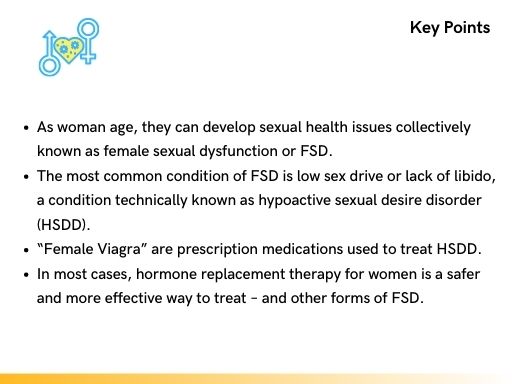 There are medications known as “female Viagra” or “pink Viagra” that are used to treat lack of libido and other forms of female sexual dysfunction.
There are medications known as “female Viagra” or “pink Viagra” that are used to treat lack of libido and other forms of female sexual dysfunction.
What is Female Viagra?
No doubt you have heard of the term erectile dysfunction or ED and the popular treatment for men suffering from the condition, the “little blue pill,” AKA Viagra.
Women also have sexual health issues. Like ED, they become more prevalent as a woman ages.
Collectively these conditions are known as “female sexual dysfunction” or FSD. FSD includes several conditions such as vaginal dryness, painful intercourse, and the inability to experience orgasm – but the most common one is hypoactive sexual desire disorder (HSDD), also known as lack of libido or low sex drive.
It is this last condition that so-called “female Viagra” is prescribed for. The FDA has recently approved two prescription drugs to treat HSDD. The drugs have gotten that nickname because of the popular ED medication for men, but they are not related chemically to Viagra and similar male drugs known as PDE5 inhibitors, and they work nothing like these drugs.
How Does Female Viagra Work?
Despite the name, the drugs known as “female Viagra” do not share anything in common with the popular ED drug in terms of formulation or how they work.
In men, ED is usually a “physical” issue. While lack of libido can accompany ED, most often, sexual desire is not the issue. Most men with ED want to have sex; they just cannot physically obtain an erection. Viagra and related medications solve that issue by increasing blood flow to the penis.
Female Viagra is designed to treat a different issue entirely, low sex drive. The two drugs often referred to as “female Viagra” or “Pink Viagra” are:
- Flibanserin is sold under the brand name Addyi. It is a pill you take daily in the evening.
- Bremelanotide is sold under the brand name Vyleesi. It’s a shot you give yourself in the belly or thigh 45 minutes before you have sex. You can only take one in a given 24-hour period, and doctors recommend only eight shots per month.
 Both drugs work the same way by raising the levels of chemicals in the female brain related to arousal and sexual desire.
Both drugs work the same way by raising the levels of chemicals in the female brain related to arousal and sexual desire.
It is important to note that neither drug improves orgasm or sexual performance in any other way; they both simply help a woman feel more “in the mood” to engage in sexual activity.
Both medications are available by prescription only, and you will need your doctor to diagnose you with HSDD prior to obtaining a prescription for either medication.
As to which version of female Viagra is right for you, that decision will be made by your doctor and yourself, based on your symptoms and lifestyle.
Also, it is important to note that both drugs are only approved for women who have not gone through menopause yet. This means that they may help women in pre-menopause or “perimenopause” who may be experiencing lack of libido, but they cannot be used in menopausal women, when loss of sexual desire is quite common.
How Long Does the Effects of Pink Viagra Last?
It is hard to measure how long the effects of female Viagra last, or if they really work at all since sexual desire is a subjective thing. Doctors say that after the use of either medication for eight weeks, if a patient is not “feeling” a significant increase in sexual desire, leading to at least one more sexual encounter a month “than normal,” it is not working, and alternatives should be considered.
Technically speaking, Addyi remains in the body for about 12 hours, and Vyleesi for about 2 to 3 hours.
What Are the Side Effects of Female Viagra?
 The drugs are not recommended for women who are pregnant, may become pregnant, or are breastfeeding. Common side effects that have been reported include:
The drugs are not recommended for women who are pregnant, may become pregnant, or are breastfeeding. Common side effects that have been reported include:
- Nausea
- Headache
- Flushing (red, warm skin)
- Dizziness and fainting
- Tiredness
- Dry mouth
Female Viagra Vs. Hormone Replacement Therapy
 The major cause of any of the conditions related to female sexual dysfunction is the declining levels of hormones that occur as a woman ages. The closer a woman gets to menopause, the more estrogen levels drop and the more likely she is to experience low sex drive and the other symptoms of FSD.
The major cause of any of the conditions related to female sexual dysfunction is the declining levels of hormones that occur as a woman ages. The closer a woman gets to menopause, the more estrogen levels drop and the more likely she is to experience low sex drive and the other symptoms of FSD.
While female Viagra may increase sexual desire to some degree, it does nothing to correct the hormonal root cause of the condition. Nor can either of the prescription drugs known as female Viagra do anything to alleviate the other FSD symptoms related to perimenopause and menopause, such as vaginal dryness, lack of orgasm, and painful intercourse.
However, hormone replacement therapy for women has been proven to reduce or eliminate all of the sexual health issues caused by age-related hormone decline. Therefore, in most cases – particularly in women whose sexual issues can be traced to low hormone levels – hormone replacement therapy is a better alternative than pink Viagra.
Hormone replacement therapy not only can improve sex drive in women, but it has also been shown to improve lubrication and return more supple and more youthful skin to the outer and inner vaginal walls, which improves stimulation and reduces issues of painful intercourse. Female Viagra cannot do any of these things.
Conclusion
While there is evidence that so-called “pink Viagra” may improve a woman’s sex drive, like its male blue pill counterpart, it treats only the symptoms of female sexual dysfunction and not its root causes.
Also, female Viagra does nothing to improve vaginal dryness, painful intercourse, or the other sexual health issues that women can face as they get older and approach their menopausal years. However, hormone replacement therapy for women has been proven to alleviate all of the sexual problems that aging women experience due to hormone loss, as well as all of the other debilitating symptoms of menopause, such as mood swings, hot flashes, and night sweats.

